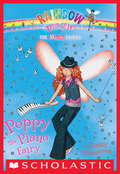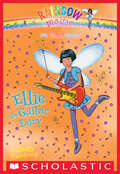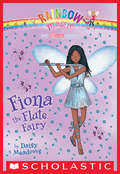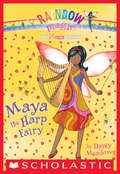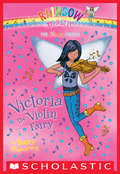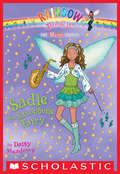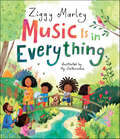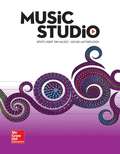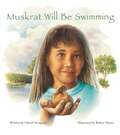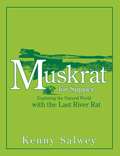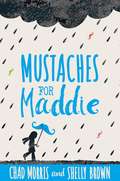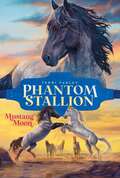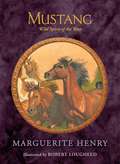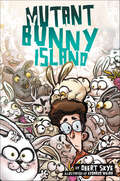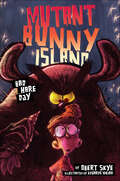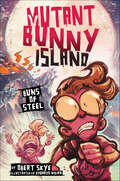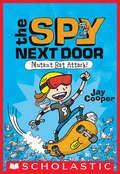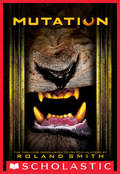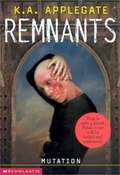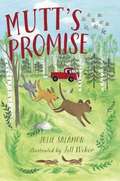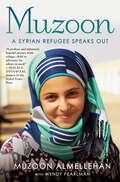- Table View
- List View
Music Fairies #1: Poppy the Piano Fairy (Music Fairies #1)
by Daisy MeadowsJack Frost and his goblins have stolen the Music Fairies' magic instruments. Music everywhere is out of tune! Now the goblins plan to play the instruments in a TV talent contest. If Rachel and Kirsty don't act fast, everyone could find out about Fairyland! <P> Poppy the Piano Fairy's magic instrument is in a music store, guarded by a grumbling goblin. What's the key to getting it back?<P> Find the magic instrument in each book and help keep Fairyland in perfect harmony!
Music Fairies #2: Ellie the Guitar Fairy (Music Fairies #2)
by Daisy MeadowsThe Music Fairies' magic instruments are missing. Now music everywhere is hitting all the wrong notes! This is our eighth group of fairies; all seven books in this group will launch at once. Jack Frost and his goblins have stolen the Music Fairies' magic instruments. Music everywhere is out of tune! Now the goblins plan to play the instruments in a TV talent contest. If Rachel and Kirsty don't act fast, everyone could find out about Fairyland! A rockin' goblin has Ellie the Guitar Fairy's instrument, and he won't give it up without a fight! Can Rachel, Kirsty, and Ellie outsmart this guitar star? Find the magic instrument in each book and help keep Fairyland in perfect harmony!
Music Fairies #3: Fiona the Flute Fairy (Music Fairies #3)
by Daisy MeadowsThe Music Fairies' magic instruments are missing. Now music everywhere is hitting all the wrong notes! This is our eighth group of fairies; all seven books in this group will launch at once. Jack Frost and his goblins have stolen the Music Fairies' magic instruments. Music everywhere is out of tune! Now the goblins plan to play the instruments in a TV talent contest. If Rachel and Kirsty don't act fast, everyone could find out about Fairyland! When the goblins play Fiona's magic flute, everyone in Wetherbury falls under its spell. But putting magic in the goblins' hands can only mean one thing --- trouble! Find the magic instrument in each book and help keep Fairyland in perfect harmony!
Music Fairies #4: Danni the Drum Fairy (Music Fairies #4)
by Daisy MeadowsThe Music Fairies' magic instruments are missing. Now music everywhere is hitting all the wrong notes! This is our eighth group of fairies; all seven books in this group will launch at once. Jack Frost and his goblins have stolen the Music Fairies' magic instruments. Music everywhere is out of tune! Now the goblins plan to play the instruments in a TV talent contest. If Rachel and Kirsty don't act fast, everyone could find out about Fairyland! Rachel and Kirsty are going to be in a music video! Danni the Drum Fairy's instrument is on set, being played by a mischievous goblin. Can the girls snare him? Find the magic instrument in each book and help keep Fairyland in perfect harmony!
Music Fairies #5: Maya the Harp Fairy (Music Fairies #5)
by Daisy MeadowsThe Music Fairies' magic instruments are missing. Now music everywhere is hitting all the wrong notes! This is our eighth group of fairies; all seven books in this group will launch at once. Jack Frost and his goblins have stolen the Music Fairies' magic instruments. Music everywhere is out of tune! Now the goblins plan to play the instruments in a TV talent contest. If Rachel and Kirsty don't act fast, everyone could find out about Fairyland! There's a wedding in Wetherbury, but the day could be ruined if Rachel and Kirsty can't find Maya's magic harp. They'll have to pull some strings to get it back! Find the magic instrument in each book and help keep Fairyland in perfect harmony!
Music Fairies #6: Victoria the Violin Fairy (Music Fairies #6)
by Daisy MeadowsThe Music Fairies' magic instruments are missing. Now music everywhere is hitting all the wrong notes! This is our eighth group of fairies; all seven books in this group will launch at once. Jack Frost and his goblins have stolen the Music Fairies' magic instruments. Music everywhere is out of tune! Now the goblins plan to play the instruments in a TV talent contest. If Rachel and Kirsty don't act fast, everyone could find out about Fairyland! The girls are determined to track down Victoria the Violin Fairy's instrument --- even if they have to crash the goblins' band practice. But will the goblins fiddle their way out? Find the magic instrument in each book and help keep Fairyland in perfect harmony!
Music Fairies #7: Sadie the Saxophone Fairy (Music Fairies #7)
by Daisy MeadowsJack Frost and his goblins have stolen the Music Fairies' magic instruments. Music everywhere is out of tune! Now the goblins plan to play the instruments in a TV talent contest. If Rachel and Kirsty don't act fast, everyone could find out about Fairyland! <P> Jack Frost and his goblin band plan to jazz up the talent contest with Sadie's magic saxophone. It's up to Rachel and Kirsty to stop them --- and save their fairy friends!<P> Find the magic instrument in each book and help keep Fairyland in perfect harmony!
Music Is in Everything
by Ziggy MarleyA picture book based on Ziggy Marley's popular song celebrating music's many forms, from the sounds of ocean waves to laughter in the family kitchen.“Readers are encouraged to find the music in everything in this picture-book adaptation of Marley’s exuberant song . . . The illustration of the family’s large and small clapping hands in a spectrum of skin tones sends a powerful, uplifting message about the universality of music . . . Close your eyes, listen to the music, and experience the joy of family with this buoyant tale.” —Kirkus Reviews"Music Is in Everything"—a single on More Family Time, the follow-up children's album to the GRAMMY Award-winning Family Time—celebrates how music is found in everything. From ocean waves to banging pots and pans in the kitchen, from a loved one's laughter to the "river's latest tune, " Marley reminds children everywhere that you don't need an instrument to create a beautiful song.With heartfelt illustrations by Ag Jatkowska—illustrator of Marley's debut picture book, I Love You Too—Music Is in Everything is a sweet and uplifting ode to the power and beauty of song.
Music Studio: Spotlight On Music [Grade 5], Song Anthology (General Music Ser.)
by Judy Bond Margaret Campbelle-Holman René BoyerNIMAC-sourced textbook
Music to Our Ears (Fountas & Pinnell LLI Purple #Level R)
by Jack SilbertText Elements <p> Genre: Expository <p> Text Structures <p> Main: Chronological Sequence <p> Embedded: Categorical, Compare/ Contrast, Cause/Effect <p> Text Features: table of contents, headings, sidebars, glossary
Muskrat Will Be Swimming
by Cheryl Savageau*Notable Books For Children - Smithsonian* *Skipping Stones Book Award for Exceptional Multicultural and Nature/Ecology Books* *Wordcraft Circle Writer of the Year (Prose - Children's Literature)* *Wordcraft Circle Mentor of the Year* Although Jeannie loves her lakeside neighborhood, her feelings are hurt by her schoolmates who live in fancier homes and call her a Lake Rat. When she confides her troubles to her grandfather, he tells her about his own childhood experiences with teasing. As the story unfolds, the grandfather shares a traditional Seneca story that helps Jeannie to find strength in her Native identity and a new appreciation for the different roles that animals play in nature. This is a quiet book that celebrates family and place and the teachings of Native people. Muskrat Will Be Swimming is based on a real incident in Cheryl Savageau's life. Muskrat Will Be Swimming will help inspire classroom conversations about: Teasing and bullying Storytelling traditions and customs in Native and non-Native families The Seneca creation story and creation stories in general Traditions of the Sky Woman in Native stories Contemporary Native American families and building connections to tribal identity Native identity and mixed-blood ancestry Significance of dreams in Native culture The role of animals as teachers in Abenaki culture Animals of the forest The Abenaki view towards the natural environment The value of experiences in the natural world for children's growth F&P Text Level R
Muskrat for Supper
by Kenny SalweyMuskrat for Supper inspires young people to explore nature's life cycles and understand the concept of the circle of life, as told through the tale of a family that embarks on a hunting and trapping adventure. It is an endearing story that weaves together such themes as sustainable living, our natural environment, and living closer to nature. The first book for children by this acclaimed storyteller and author, Muskrat for Supper includes questions young people have asked Kenny Salwey about his lifestyle as a river rat living off the land. The story will be illustrated with black-and-white photographs as well as nonfiction material to supplement the text. Kenny Salwey is the last of a breed of men whose lifestyle has all but disappeared in this fast-paced, high-tech digital world. For thirty years, this weathered woodsman eked out a living on the Mississippi River running a trapline, hiring out as a river guide, digging and selling roots and herbs, and eating the food he hunted and fished. Today Salwey is a master storyteller, environmental educator, keynote speaker, nature writer, and advocate for the Upper Mississippi River. He has presented his true-life adventures and words of natural world wisdom to both adult and young audiences across the upper Midwest. By sharing his hard-learned experiences, his respect for the Mississippi River, and his love of the natural world, Salwey hopes to inspire his audiences to protect this precious and fragile ecosystem.
Mustaches For Maddie
by Chad Morris Shelly BrownTwelve-year-old Maddie has a quirky sense of humor and loves making her classmates laugh by slapping on fake mustaches every chance she gets. Being funny gets her noticed by class queen Cassie, and things are looking up when Maddie is cast as Juliet in the school play. Maybe Juliet could wear a mustache? <p><p> When Maddie starts tripping when she walks and her hand starts curling up at her side, her mom takes her to the doctor, who confirms Maddie has a brain tumor. In an instant, her world is turned upside down. <p> Maddie doesn't want anyone else to know. Especially Cassie, whose jealousy has turned to bullying. What about Maddie's chance to play Juliet opposite the cutest boy in the sixth grade? What if the doctors can't get the ugly tumor monster out of her brain? <p> As Maddie's surgery approaches, she wonders if her illness is giving her super powers because her imagination is bigger than ever, her courage is stronger than ever, and her compassion is about to be felt by more people than she ever imagined.
Mustang Moon (Phantom Stallion #2)
by Terri FarleyThe beloved second book in the middle grade Phantom Stallion series about a girl, her horse, and the beauty of the American West returns with a brand-new, stunning cover and bonus material! Perfect for fans of Canterwood Crest and classic horse stories like Black Beauty and My Friend Flicka.Sam has befriended the mysterious, powerful mustang known as the Phantom, and she&’s determined to defend his freedom on the open range. But when tame mares start going missing from local ranches, the Phantom becomes the number one suspect—and there&’s one rancher who would use any excuse to capture the wild white stallion. When a reward is offered to anyone who can bring the Phantom in, Sam is no longer just fighting for his freedom—she&’s fighting for his life.
Mustang: Wild Spirit of the West (Marguerite Henry Horseshoe Library)
by Marguerite HenryHorses were in Annie Bronn’s blood. For as long as she could remember, she had been fascinated by the spirited wild mustangs that roamed free throughout the West. So when greedy cattlemen started to round up the mustangs for slaughter, Annie knew it was up to her to save the breed. The true story of Wild Horse Annie’s crusade to save the mustangs is inspiring. Readers will cheer her on, all the way to the White House, in her struggle to preserve these beautiful creatures from extinction.
Mutant Bunny Island (Mutant Bunny Island #02)
by Obert SkyeObert Skye, author of the bestselling Leven Thumps series, delivers a delightful mixture of offbeat mystery and laugh-out-loud humor in this thoroughly inventive adventure complete with comic-style illustrations, the first in a trilogy.Ten-year-old Perry Owens has learned everything he needs to know from comic books. So when Perry receives a troubling message from his favorite uncle, Zeke, he knows exactly what’s wrong. Obviously, evil newts wearing trench coats must have kidnapped Zeke. Now they’re holding him hostage somewhere on Bunny Island, the remote vacation destination that Zeke calls home. On his own, Perry travels to Bunny Island, where dozens of bunnies are running wild. One in particular doesn’t seem quite right. A creature this cute shouldn’t exist in nature. Are there truly evil newts on the loose, or something much stranger...and more disturbingly adorable?
Mutant Bunny Island: Bad Hare Day (Mutant Bunny Island)
by Obert SkyeThe second book in this hilariously inventive trilogy from Obert Skye, author of the bestselling Leven Thumps series, comes with all the spills, chills, and thrills you’d expect—along with zany fully illustrated comic-style chapters to enliven the adventure!When Perry is invited back to Bunny Island for its first-ever Carrot Con, he’s beyond happy to have the chance to reconnect with his favorite uncle, Zeke, and his friends, Juliet and Rain.After stopping Mayor Lapin and his dastardly plan to turn everyone into rabbits, Perry is psyched just to have a normal visit. But then freak microstorms pop up all over the island, ruining his fun before its even begun. Perry is quickly convinced that it isn’t the weather that’s to blame for all the destruction.Perry’s ready to gather his friends to solve another Mutant Bunny-style mystery when Uncle Zeke gets locked up for a crime he didn’t commit. Can Perry and his friends prove Uncle Zeke’s innocence and save Bunny Island a second time around?Perry is going to have to pull off something drastic and heroic to foil this hare-rrificly evil plot. It’s second title in the much-loved series that School Library Journal saidwould amuse young readers who are looking for "fast-paced books with unlikely, hyperactive heroes, and outlandish adventures.”
Mutant Bunny Island: Buns of Steel (Mutant Bunny Island #3)
by Obert SkyeNo matter how many times Perry Owens saves Bunny Island from a hare-rrificly evil plot, another rabbit-filled crisis lurks around the corner! Join Perry on his adventures in the final book of this hilariously inventive trilogy from Obert Skye, author of the bestselling Leven Thumps series.Perry’s return to Bunny Island just isn’t going as planned at all. His uncle Zeke is tied up at his new job, and his best friends Juliet and Rain are too busy to notice the island’s sudden spike in really angry rabbits.But when Perry makes the hare-raising discovery that these dastardly bunnies are actually robot rabbits, he realizes it’s up to him to figure out who is behind these buns of steel.Time is running out for Perry and his pals as thousands and thousands of rabbit holes are springing up across the island, threatening to tear it apart.Join Perry and his friends as they try to get to the bottom of what’s destroying Bunny Island in this hilariously harrowing bun-tastic adventure from beloved author Obert Skye.
Mutant Mantis Lunch Ladies!: A Monstertown Mystery (Monstertown Mysteries #2)
by Bruce HaleHow well do you know the lunch servers at your school? Sure, they seem like nice people, but what if secretly they are something much, much weirder? Best friends Carlos and Benny, who just saved their teacher from becoming a were-hyena, have been called upon to investigate the strange goings-on in the cafeteria. Why are the lunch ladies suddenly so grumpy? Why are the girls' meals different from the boys'? And what was that thing seen scuttling around the kitchen wearing an apron? It's going to require a lot of courage--and more than an industrial size can of Raid--for the boys to avoid extermination in this buggy adventure.
Mutant Rat Attack! (The\spy Next Door Ser. #1)
by Jay CooperA funny and fresh debut with hilarious illustrations aimed squarely at fans of CAPTAIN UNDERPANTS and THE YETI FILES!Nothing exciting ever happens to boring Dex at his boring home or at boring school. He oversleeps (again!), he daydreams while his science teacher Mr. McFur babbles on about his lab rat Princess Pretty Fabulous (Pretty for short), he gets harassed by Millicent (the neighborhood meanie): boring, boring, ultra-boring! Then one day, a mystery man convinces Mr. McFur to feed Pretty radioactive gamma broccoli, which turns the rat into a rabid rodent the size of a hippo and launches Dex into an underground world of kid spies and rat gas power.Suddenly Dex's life doesn't seem so boring anymore! But who was that mystery man? What does he want? And most importantly, can a boring Dex shed the boring to become the most unlikely hero in spy history?
Mutation (Cryptid Hunters #4)
by Roland SmithMonsters of legend come to life! The final thrilling title in Roland Smith's popular Cryptid Hunters series.Marty and his best friend, Luther, have managed to rescue Marty's cousin Grace from the clutches of the nefarious pseudo-naturalist Noah Blackwood, but their most dangerous mission lies ahead of them. Marty's parents have been missing in Brazil for months, and their trail has all but run cold. With time running out, Marty and the Cryptos Island crew race off for Brazil -- where they discover that Noah Blackwood has twisted the natural order of things beyond their wildest, most terrifying dreams.
Mutation (Remnants Series #5)
by K. A. ApplegateThe end of the world has come . . . and gone. There is a computer called Mother that runs the ship keeping the remaining members of the human race alive. And that computer has the ability to create imaginary worlds filled with things that don't-can't-exist. The problem is that this computer has evolved. It experiences emotion. And it is out of control. Jobs, Mo'Steel, 2Face, Billy, and the other Remnants are struggling to survive withing Mother's environments. But they are not all surviving. And they've discovered new Remnants-one of which has undergone a strange mutation. A mutation that has made him into a living, breathing monster. . . .
Mutiny on the Bounty (Signet Classics #19)
by William BlighCast out from their ship by Fletcher Christian and his rebel band, William Bligh and eighteen seamen were forced to journey thousands of miles to the nearest port in a small open boat, with inadequate supplies and without a compass or charts. This time-honored classic, written in 1790, is Bligh's personal account of an extraordinary feat of seamanship, in which he used a sextant, a pocket watch, and his own iron will to direct an ill-equipped vessel and crew to safety across nearly 4,000 miles of rolling sea.Bligh's memoir also recounts the events of a routine voyage of scientific exploration to Tahiti that achieved legendary status when it erupted into the world's most famous mutiny. The captain's narrative offers a marked contrast to the familiar tale of film and fiction. Anyone who thrilled to the Bounty movies, along with all lovers of maritime adventure, will be captivated by this story of daring and perseverance.
Mutt's Promise
by Julie Salamon Jill WeberFans of The Incredible Journey and Old Yeller will love this endearing, page-turning dog adventure story Luna is a farm puppy who loves to dance, and has only known a happy, serene life surrounded by her mother, Mutt, and her siblings, and cared for by Gilberto, the son of farm workers. But now Gilberto and his parents have moved on, and Mr. Thomas the farmer doesn't feel he can take care of a whole family of dogs. He finds new homes for the puppies, not realizing that the man who took Luna and her brother does not have their best interests at heart. Luna and Chief, hungry and scared, are trapped in the smelly barn of a puppy mill--until they take matters into their own paws and find a way to escape. But can Luna and Chief find their way home? With a lovable cast of animal characters and endearing illustrations, this charming story is a perfect read-aloud for fans of classic children's novels like Gentle Ben, A Cricket in Times Square, and Shiloh.
Muzoon: A Syrian Refugee Speaks Out
by Wendy Pearlman Muzoon AlmellehanWhen her family had to flee Syria, 14-year-old Muzoon was told to pack only the most essential things—and so she packed her schoolbooks. <p><p> This is the inspiring true story of a Syrian refugee who fought hard for what she needed—and grew into one of the world’s leading advocates for education. <p><p> This eye-opening memoir tells the story of a young girl’s life in Syria, her family’s wrenching decision to leave their home, and the upheaval of life in a refugee camp. Though her life had utterly changed, one thing remained the same. She knew that education was the key to a better future—for herself, and so that she could help her country. She went from tent to tent in the camp, trying to convince other kids, especially girls, to come to school. And her passion and dedication soon had people calling her the “Malala of Syria.” <p><p>Muzoon has grown into an internationally recognized advocate for refugees, for education, and for the rights of girls and women, and is now a UNICEF goodwill ambassador—the first refugee to play that role. <p><p>Muzoon’s story is absolutely riveting and will inspire young readers to use their own voices and stand up for what they believe in.
